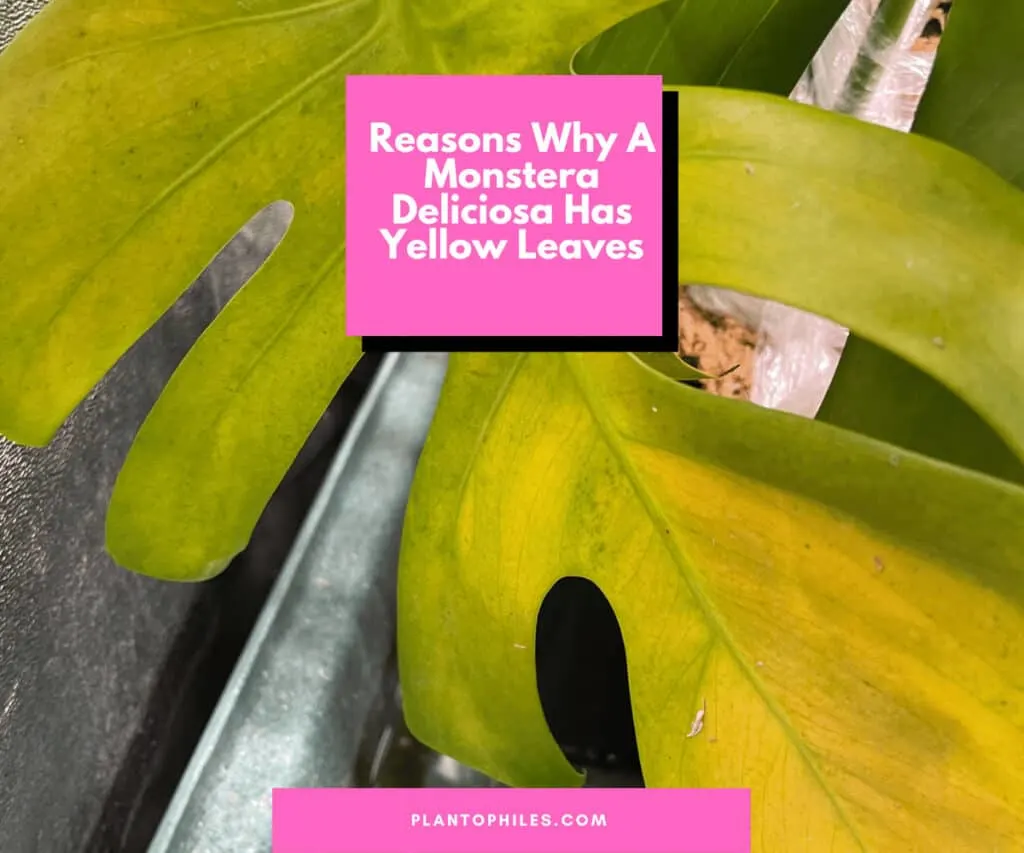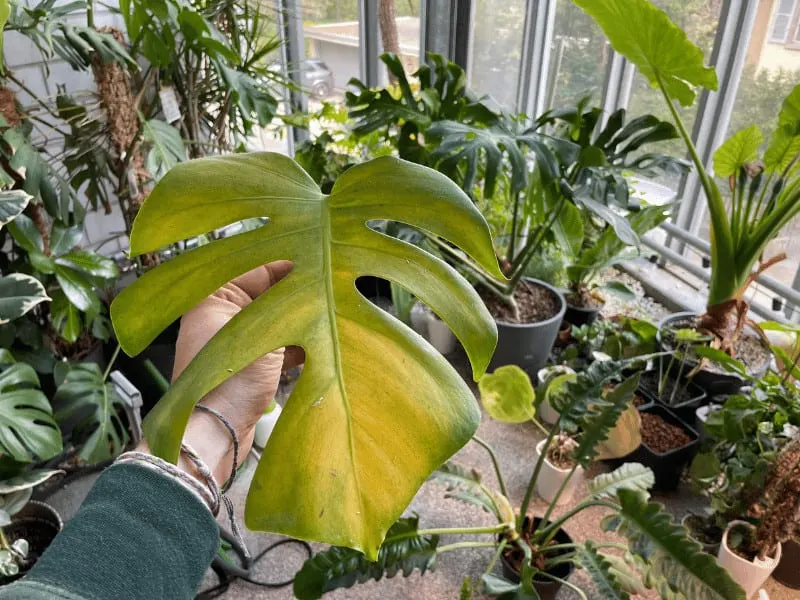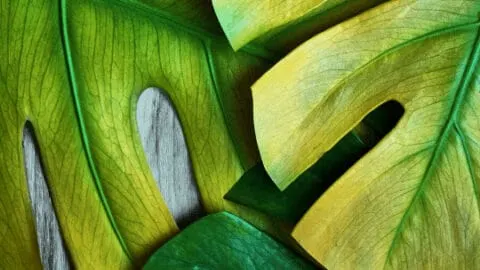Why does my Monstera deliciosa have yellow leaves? Monstera Deliciosa is a timeless tropical plant of Araceae, the aroid family. Its name derives from the Latin word implying “abnormal.” It is named after its odd-looking, pierced leaves that often have holes through them.
This plant is native to Southern Mexico; it is an aroid that provides an edible fruit. The Deliciosa name of it comes from the delicious fruit it gives and Monstera due to its massive size.
But when the care of these houseplants is not on point, they will show you by developing yellow leaves.
Table of Contents
Why Does My Monstera Deliciosa Have Yellow Leaves?
There are a ton of reasons that can cause the yellowing of leaves on your Monstera Deliciosa. The most common ones are improper watering, temperature change, light problem, low humidity, and/or transfer of the plant. Sometimes pests and diseases also attack your plant and cause the yellowing of leaves. Treat the yellowing of the leaves based on the reason.

Monstera leaves turning yellow
My Monstera deliciosa leaves mostly turn yellow when I overwater my plants. Another reason I have identified is when the plants are stressed due to sap-sucking insects depriving them of essential nutrients.

1. Improper Watering
Improper watering is the most widespread reason for yellowing leaves on your Monstera deliciosa. If the plant is getting yellow leaves, it is vital to check the soil first.
Overwatering generally causes the yellowing leaves, starting from the lower leaves of your plant. Underwatering will cause the edges of the leaves to turn yellow and then slowly drop and die.
Overwatering makes your soil soggy and wet, causing the moisture in the soil to rise. This will eventually cause the leaves to turn yellow and also prone to root rot. The soil of your Monstera Deliciosa should remain damp but not wet.
Underwatering dehydrates your soil; it does not get sufficient water to supply to the rest of the plant.
When your Monstera deliciosa does not receive the essential amount of water, the first problem is yellow leaves.
2. Temperature Changes
Monstera Deliciosa is a tropical plant. Therefore, it prefers a temperature between 65-80 degrees Fahrenheit (18.3-26.6 degrees Celsius). When the temperature starts to fall below this level, the plant’s growth slows, and leaves begin to turn yellow.
Likewise, Monstera Deliciosa will not do very well in extremely hot temperatures.
If your plant is placed very close to a window in direct sun or close to a heating appliance, it will surely turn the leaves yellow. The next thing is the dropping of leaves and, ultimately, the death of the plant.
Hence it is highly advised that you place your Monstera Deliciosa at a place with an absolute and perfect temperature.
3. Lighting Issues
Improper lighting at your home can be another cause behind the yellow leaves on your Monstera Deliciosa. This tropical plant prefers bright indirect sunlight.
When your plant is placed in direct sunlight, the leaves turn yellow. It will be beneficial if you move your plant to a place where there is a perfect light environment.
Although this plant can adapt to low-level lights, plant growth can slow if given too little light. If your plant does not obtain sufficient light, the foliage of the plant will begin to turn yellow.
Light is very important for your plant as it facilitates chlorophyll production. Chlorophyll is extremely important for your plant as it ensures the green and glossy color of your Monstera Deliciosa. No chlorophyll means no green color and, therefore, yellow leaves.
4. Humidity Issues
Perfect humidity is extremely important for this tropical plant. Any humidity issue is going to cause problems for your Monstera Deliciosa. This plant loves to stay in high humidity to grow healthy and happy.
A low humidity level in the room turns the edges of leaves brown and then the yellowing of the entire foliage. Increase the humidity across the plant by misting the leaves or grouping it with other plants.
The ideal humidity for Monstera deliciosa is between 50-60%.
5. Transfer
If you transfer or disturb the root system of your Monstera deliciosa at the wrong time of the year, it will most probably develop yellow leaves. You will likely notice yellow leaves after you have repotted your plant, as the plant might be undergoing transplant stress.
This could be due to repotting in different potting soil, roots exposed for too long, or the new location is not right for your plant.
6. Pests
Weak and stressed Monstera Deliciosa becomes more prone to the infestation of pests. If no proper care is taken of your plant, these pests will have the best time of their life by eating up your plant.
Damage caused by pests to your Monstera Deliciosa includes yellow spots or the entire yellowing of the leaves. Pests that generally cause yellow leaves are aphids and spider mites. These sap-sucking bugs eat up the juice of your plant.
Aphids appear like very tiny insects resembling rice grains. They are mostly found on the leaves and stems of Monstera Deliciosa. It reduces your plant’s metabolism, leading to twisted and yellow leaves.
Spider mites are very insignificant in size and hard to be noticed. They can be easily detected if you notice webs on your plant’s leaves. If you do not get rid of them, they will suck up the nutrients of your leaves, turning them yellow.
You must take great care of your Deliciosa plant and keep it safe from pests.
7. Diseases
Numerous plant diseases can cause your Monstera Deliciosa to have yellow leaves, such as mealybugs, thrips, aphids, whiteflies, and scale insects. It is recommended to keep an eye on these diseases and get rid of them immediately.
8. Powdery Mildew
This disease is not very serious but can cause your Monstera Deliciosa to fade, turn yellow and even die. Before all this happens, you will observe powdery white growth on the leaves of your plant. You should remove the infected foliage or use neem oil to treat it.
9. Fungal Leaf Spot
This fungus appears as a brown spot with yellow margins on the leaves. Fungal Leaf Spot is most probably transferred by soil. Remove the infected plant and never wet the leaves while watering, as this will further spread the fungus.
Frequently Asked Questions About Monstera Delciosa And Yellow Leaves
Can yellow Monstera Deliciosa leaves regain their original color?
Unfortunately, you cannot revive the leaves that have turned yellow. You have to throw your spoiled plant leaves. To keep your plant safe from yellow leaves, take good care of its watering, light, and fertilization needs.
Should I remove the yellow leaves?
To promote the healthy growth of Monstera Deliciosa, it is important to eliminate the yellow leaves. This helps the plant utilize the nutrients for healthy leaf growth, as yellow leaves will not turn green again.
Why are my Monstera leaves turning yellow?
Monstera leave are telling yellow because your Monstera is not doing well. Many reasons can cause this from overwatering to underwatering to pests, suboptimal nutrient levels and stress.
Why do Monstera bottom leaves yellow?
If the bottom leaves of a Monstera are yellow, it is usually a normal occurrence. When leaves get older, they yellow, wilt and die.
Why does my Monstera yellow and brown leaves?
Yellow and brown leaves indicate insufficient humidity. Either the soil is too dry or the air humidity. Or it can be both. Water frequently and increase the humidity using a humidifier or moving the plant to a different location. Another reason for yellow and brown foliage can be sunburn. Avoid direct sunlight for more than 3-4 hours a day.
Why does my Monstera have yellow spots?
Yellow spots usually indicate either a fungal infection or pests. Pest sucks the plant sap and leaves behind little holes and spots. Treat pests with a systemic insecticide if the infection is bad. Fungal infections such as bacterial leaf spot will level brown and yellow spots on the leaf. Treat with a fungicide.
Takeaways
Monstera deliciosa develops yellow leaves because of the following:
- Watering Issues
- Temperature Changes
- Lighting Issues
- Humidity Problems
- Transfer
- Pests
- Diseases
- Powdery Mildew
- Fungal Leaf Spot

Daniel has been a plant enthusiast for over 20 years. He owns hundreds of houseplants and prepares for the chili growing seasons yearly with great anticipation. His favorite plants are plant species in the Araceae family, such as Monstera, Philodendron, and Anthurium. He also loves gardening and is growing hot peppers, tomatoes, and many more vegetables.


